Spider Identification in Arizona: A Complete Guide
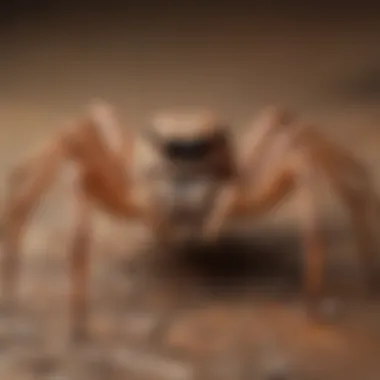
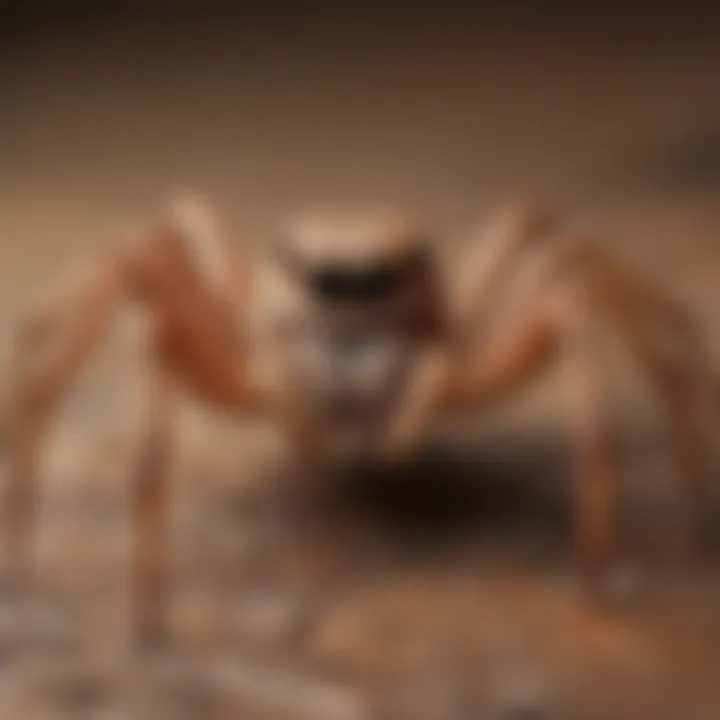
Intro
Understanding spider identification in Arizona is a significant yet often overlooked aspect of living in this unique ecosystem. Arizona is home to a multitude of spider species, each possessing distinct traits, behaviors, and habitats. This guide seeks to illuminate these aspects, allowing readers to identify spiders accurately and safely.
By exploring the ecological roles of these arachnids, we aim to dispel common myths surrounding them. Knowledge of their importance in pest control and biodiversity contributes to a healthier awareness of the environment. This resource is structured to cover various important themes, emphasizing safety precautions and engagement with both nature and local communities.
The following sections will delve into specific areas of spider identification, providing a blend of ecological insights and practical safety tips.
Understanding Spider Habitats
To accurately identify spiders, it's crucial to first understand their habitats. Arizona offers diverse environments, from arid deserts to lush wetlands, each supporting different spider species.
Key Habitats
- Desert Regions: Most common species like the Arizona Brown Spider thrive here. They enjoy seclusion under rocks or in crevices.
- Woodlands: Species such as the Orb-Weaver are often found in these areas, creating intricate webs between trees.
- Urban Areas: Many spiders adapt well to human environments, often entering homes. Understanding these habitats aids in recognizing spider behavior and preferences.
In each habitat, spiders play a critical role in controlling insect populations. This natural pest management is beneficial for gardeners and homeowners alike.
Safety Precautions and Spider Encounters
While spiders are generally harmless, some species can pose risks. It is vital to know how to handle encounters safely.
Identifying Dangerous Species
- Black Widow: Recognizable by its glossy black body and red hourglass marking. Its bite is venomous and requires medical attention.
- Brown Recluse: Identified by its violin-shaped marking on the back. This spider's bite can cause skin necrosis.
Best Practices for Encountering Spiders
- Do not provoke: If you find a spider, observe it from a distance. Most will avoid confrontation.
- Leave them be: If inside your home, consider relocating them outside gently rather than killing them.
Respecting spiders in their natural habitats fosters understanding and mitigates fear.
Community Resources and Engagement
Engaging with the community can enhance your knowledge of spider species. Various resources can serve as helpful tools for further learning.
Recommended Resources
- Books: “Spiders of the Southwest” provides in-depth identification information.
- Websites: The Arizona Game and Fish Department offers detailed resources on local wildlife.
- Online Forums: Reddit communities like r/entomology provide spaces to ask questions and share experiences.
Participating in local workshops or nature walks can also broaden your understanding of spiders and their ecosystems.
By gaining knowledge of spider identification, readers can navigate the complexities of their environment with confidence. We will explore further sections, delving into specific identification strategies and enhancing awareness of these delicate creatures.
Prelims to Spider Identification
Understanding how to identify spiders, especially in a region as ecologically diverse as Arizona, is paramount for both safety and appreciation of these creatures. The vast array of species can present challenges, making accurate identification crucial for many reasons, including pest control, ecological balance, and health awareness.
Importance of Accurate Identification
Accurate spider identification serves several important functions. First, being able to distinguish between venomous spiders, such as the black widow, and non-venomous ones reduces unnecessary panic and helps prevent harmful encounters. Furthermore, understanding the specific characteristics and behaviors of various species aids in pest management, as some spiders play beneficial roles by controlling insect populations. In the context of education, promoting awareness can help alleviate fears surrounding these creatures, fostering a more informed populace that respects their role in the ecosystem.


Overview of Arizona's Spider Diversity
Arizona's geography encompasses deserts, forests, and mountains, contributing to a rich diversity of spider species. From the urban settings of Phoenix to the cooler elevations of Flagstaff, the range of habitats supports many different types of spiders.
In total, over 300 species can be found across Arizona. These include common species such as the black widow, brown recluse, wolf spider, tarantulas, and jumping spiders. Each species has adapted uniquely to their environment, offering a fascinating insight into their survival strategies.
"The spider diversity in Arizona symbolizes the intricate web of life existing within diverse ecosystems, highlighting the importance of every organism in the balance of nature."
By recognizing these species and understanding their habitats, pet owners and nature enthusiasts can better coexist with the spider populations around them. This awareness not only enhances personal safety but also enriches the appreciation for the ecological roles spiders play, making spider identification an essential skill for those living in or visiting Arizona.
Common Spider Species in Arizona
Understanding the common spider species in Arizona is crucial for any resident or visitor. Knowledge of these spiders helps in various ways. Firstly, it aids in recognizing which species are venomous and which are harmless. For pet owners or families, this is essential for safety. Secondly, identifying local species enhances the appreciation of biodiversity in Arizona's unique ecosystems. Each spider contributes to the larger ecological web, affecting pest control and plant pollination. Finally, awareness of common spiders allows for informed decisions during encounters, reducing unnecessary panic or harm. This section covers notable species to give you a comprehensive understanding.
Black Widow Spider
Physical Characteristics
The Black Widow Spider is well-known, primarily due to its distinctive appearance. It has a glossy black body and a characteristic hourglass marking on its underside, typically red. This key identification feature makes it easier for individuals to recognize it in the wild. Notably, its size ranges from 1.5 to 5 centimeters, which varies as it matures. This size can make it appear intimidating, but it is primarily reclusive. Understanding these physical traits helps observers to distinguish Black Widow Spiders from others.
Behavior and Habitat
Black Widow Spiders tend to inhabit dark, secluded areas, such as piles of rocks or wood. Their behavior is largely solitary. They prefer to stay hidden, only emerging at night to hunt. This nocturnal behavior is advantageous, as it minimizes encounters with humans. Recognizing their habitat enhances safety for homeowners. If you see a web in a shaded corner, it’s advisable to identify if a Black Widow is present before interacting with it.
Health Risks
The venom of the Black Widow Spider is potent and can pose serious health risks to humans. Symptoms of a bite can include severe pain, muscle cramps, and, in some cases, lethargy. Some individuals may experience more severe reactions, especially children or those with compromised immune systems. Awareness of these risks is crucial to ensuring safety. Understanding what to do in case of a bite can be life-saving and help reduce fear surrounding these spiders.
Brown Recluse Spider
Identification Features
The Brown Recluse Spider is characterized by its violin-shaped marking on its back, which can be quite subtle. Typically, its body is a light brown color, and it measures about 6 to 20 millimeters. This unique feature is vital for identifying the spider correctly. Knowing what to look for can prevent misunderstandings with similar species. It plays an essential role in this guide, as misidentification can lead to unneeded concern.
Preferred Environments
This spider thrives in warmer climates and is often found in areas like attics, basements, and closets. Its tendency to hide in crevices and clutter makes it less visible, increasing the potential for accidental encounters. Knowing their preferred habitats helps homeowners recognize areas to monitor for Brown Recluse Spiders, which is essential for both safety and management.
Treatment for Bites
A Brown Recluse bite can be serious. Symptoms may include pain and ulceration of the skin. Initial treatment typically involves keeping the affected area still and seeking medical attention. In some cases, surgical intervention may be required to address the damage. Recognizing the signs can make a difference in the effectiveness of treatment. This information is vital for the reader to feel prepared.
Wolf Spider
Distinctive Traits
Wolf Spiders are large, robust spiders with long legs. They do not spin webs to catch prey; instead, they actively hunt. Their coloration ranges from gray to brown, often with stripes or spots. This distinctive feature aids in camouflage, allowing them to blend into their surroundings. Recognizing these traits can help prevent unnecessary fear, as they are generally harmless and beneficial.
Behavioral Patterns
The hunting behavior of Wolf Spiders sets them apart from web-slinging spiders. They are agile and quick, often pouncing on prey. Their active hunting methods require them to roam extensively. This trait contributes to controlling pest populations, a beneficial aspect for gardeners and homeowners. Understanding their behavior provides insight into their role in the ecosystem.
Role in Ecosystem
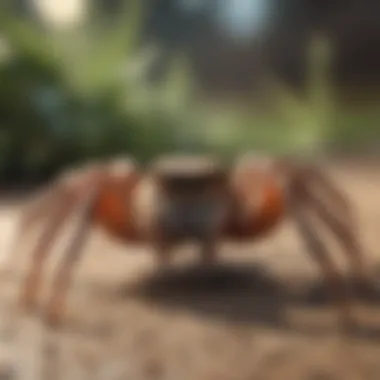
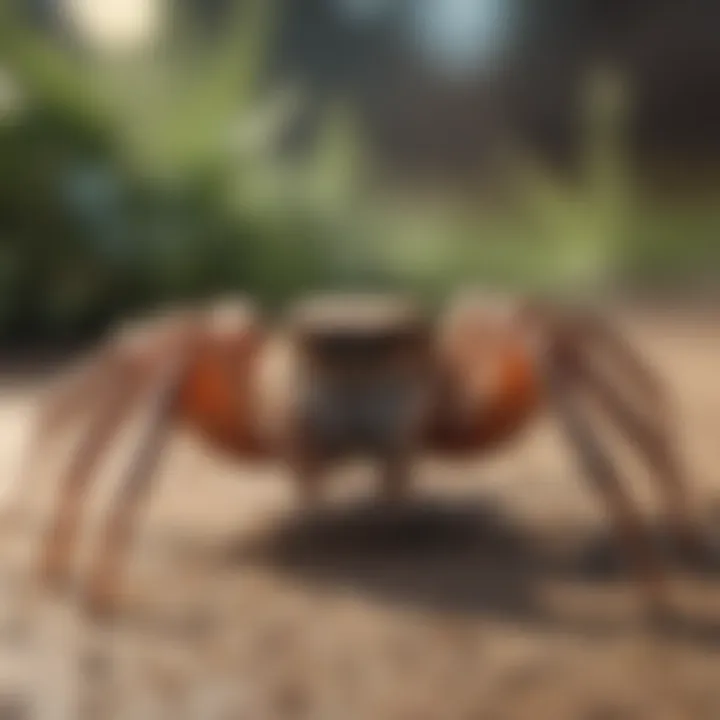
Wolf Spiders play a significant role in pest control. They reduce the populations of insects and other small creatures that could become pests. This natural form of pest control can be advantageous for those who prefer to avoid chemical insecticides. Promoting the presence of Wolf Spiders can benefit the overall health of gardens and homes.
Tarantulas
Physical Description
Tarantulas are among the most recognized spiders. Their large size, ranging from 10 to 25 centimeters, can be daunting. They are covered in hairs which can cause irritation if they come in contact with skin. Despite being intimidating in appearance, Tarantulas are generally docile and prefer to flee than confront threats. This knowledge can lead to more peaceful interactions with these fascinating creatures.
Habitat Preferences
Tarantulas favor dry, warm environments. They often make their homes in burrows or beneath rocks. These habitats provide shelter from predators and harsh weather. Recognizing where they might live can help people avoid accidental encounters. It also emphasizes the importance of respecting their habitat for ecosystem balance.
Care Options for Pets
As pets, Tarantulas require specific care. Their habitat needs to mimic their natural environment, with proper temperature and humidity. Although they can be low-maintenance pets, it is crucial for potential owners to understand their needs. Effective care can lead to a rewarding experience for those interested in keeping these spiders as pets.
Jumping Spiders
Visual Identification
Jumping Spiders are small, usually 0.5 to 2.5 centimeters. They have large anterior eyes, giving them excellent vision. Their distinct body shapes, often robust and hairy, add to their unique visual appeal. Recognizing these characteristics helps to easily identify them. Getting to know these features is beneficial for those interested in observing spiders in their natural behavior.
Predatory Behavior
These spiders are known for their impressive jumping abilities. They stalk and pounce on their prey, making them delightful to watch. The predatory behavior contributes to pest control and adds an element of wonder when observed in nature. Understanding this behavior helps people appreciate their role in controlling bug populations.
Interaction with Pets
Jumping Spiders are usually harmless to pets. However, pet owners should still monitor interactions. Curious pets may provoke spiders, leading to misunderstandings. Educating pet owners on how to manage these interactions is essential for safety and the well-being of both pets and spiders.
Behavior and Ecology of Spiders
Understanding the behavior and ecology of spiders is crucial in appreciating their role in the ecosystem of Arizona. The intricate relationships that these arachnids maintain with other organisms provide insights into their contributions to natural pest control and overall biodiversity. Furthermore, recognizing their habits can enhance safety measures for pet owners and those who might encounter spiders.
General Spider Behavior
Spiders exhibit a range of behaviors that are fascinating and highly adaptive. Most spiders are solitary creatures and do not form social groups. They often exhibit specific hunting techniques, which can include web-building, ambush, or active hunting.
Key behaviors include:
- Web-building: Many species, like the orb-weaver, construct intricate webs to catch prey. These webs can be observed in various environments throughout Arizona.
- Hiding: Spiders such as the brown recluse prefer to stay hidden in dark, secluded areas which helps them avoid predators.
- Hunting: Active hunters, like wolf spiders, rely on their speed and agility. They patrol the ground or foliage, stalking their prey without the use of webs.
By observing these behaviors, one can gain a better understanding of how to identify different spider species in Arizona and avoid any potentially dangerous encounters.
Role of Spiders in Pest Control
Spiders play an essential role in the natural control of pest populations. They are natural predators and help maintain the balance within the ecosystem. By consuming insects that can damage crops or spread diseases, spiders contribute to the overall health of both the agricultural and urban environments.
Benefits include:
- Reduction of Pest Populations: Spiders feed on numerous harmful insects such as mosquitoes and flies, effectively controlling their populations.
- Natural Pest Management: Spiders do not require chemicals for pest control, making them an eco-friendly option.
- Biodiversity Support: Maintaining spider populations helps support a wider range of species within their habitats.
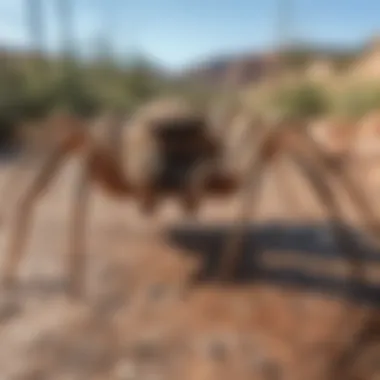
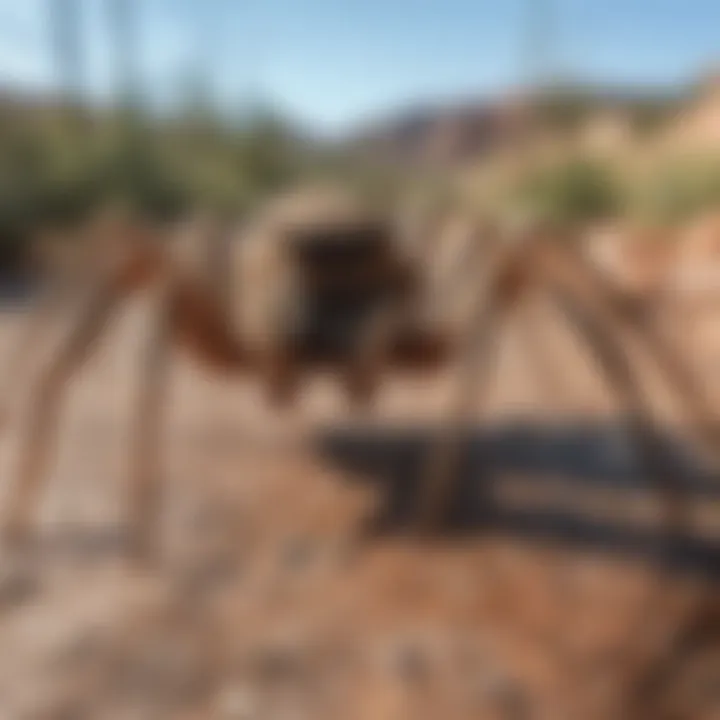
Identifying Spiders Safely
Understanding how to identify spiders safely is crucial, especially for residents and visitors in Arizona where many spider species thrive. Not only does this knowledge help in avoiding unnecessary panic or mishaps, but it also equips pet owners and nature enthusiasts with the right tools to manage spider encounters effectively. Having both safety precautions and best practices will lead to more confident interactions with these arachnids.
Safety Precautions
Being cautious is essential when identifying spiders. Some species, such as the Black Widow, can be venomous. Thus, it’s important to take the right measures when encountering one. Consider the following safety precautions:
- Avoid Close Contact: Maintain a safe distance from unknown spiders. This is especially relevant in dimly lit areas where visibility is limited.
- Wear Protective Gear: If you have to handle or move a spider, use gloves to prevent bites.
- Light Up Dark Areas: Use a flashlight to inspect dark corners where spiders may reside. Illuminate potential spider habitats, such as garages or basements, to see what creatures might be hidden.
- Educate Yourself: Familiarize yourself with local spider species. Knowledge helps in proper identification which can alleviate fears and promote safety.
Safety first: Misidentifying a spider can lead to avoidable encounters with dangerous species.
Implementing these precautions can significantly reduce the risk of an unexpected bite or an allergic reaction. When dealing with spiders, it is always better to err on the side of caution.
Best Practices in Handling Encounters
How you approach an encounter with a spider can determine the outcome. Here are some recommended practices:
- Stay Calm: If you see a spider, try not to panic. Remaining calm is the best first step to handling any unexpected meeting.
- Observe First: Take a moment to observe the spider from a distance. Identifying features such as color, size, and movement patterns can help you assess the type of spider.
- Use Tools for Removal: If you need to relocate a spider, use a cup and paper or a jar and a piece of cardboard. This allows for a humane catch and release without direct contact.
- Seek Help if Needed: If you are uncertain about the spider, do not hesitate to contact local pest control or a wildlife expert. They can identify the spider and suggest safe removal techniques.
By incorporating these practices, individuals can safely navigate their encounters with spiders, minimizing threats to themselves and their pets. Ultimately, being informed can transform fear into understanding, enriching the overall experience of engaging with the natural world.
Spider Myths and Misconceptions
Understanding spider myths and misconceptions is crucial for promoting a realistic view of these creatures. Many people hold beliefs about spiders that are not only inaccurate but can also lead to unnecessary fear. This section seeks to dispel common myths while highlighting the role spiders play in our ecosystem. Accurate information fosters better coexistence between humans and spiders, reducing anxiety and encouraging informed discussion.
Common Myths
- All Spiders are Dangerous
A prevalent myth is that every spider poses a threat to humans. While some spiders, like the Black Widow, carry venom harmful to people, the vast majority are harmless. In fact, most spiders are beneficial as they control pest populations in gardens and homes. - Spiders Chase People
Spiders do not chase humans. They are not aggressive creatures by nature. If a spider does move towards a person, it is likely a response to curiosity or a misunderstanding. Most often, spiders prefer to avoid human contact altogether. - Spiders Bite While Sleeping
Many believe they can be bitten by a spider while asleep. While this is theoretically possible, instances are extremely rare. Spiders do not typically seek out humans as prey and will only bite when they feel threatened.
Fact vs.
Fiction
It is essential to distinguish fact from fiction regarding spiders to improve understanding and reduce misconceptions.
Fiction 1: Spiders are insects.
Fact: Spiders are arachnids, a different class than insects. They have eight legs and no antennae, unlike insects which have six legs and often possess antennae.
Fiction 2: A spider's web is always sticky.
Fact: Not all spider silk is sticky. Different species produce different types of silk for various purposes, including constructing webs, wrapping prey, and creating draglines.
Fiction 3: Using a shoe is the best way to deal with a spider.
Fact: Killing a spider can upset the local ecosystem. It’s better to capture and release if possible, which allows the spider to continue its role in pest control.
End
Understanding the intricacies of spider identification in Arizona is crucial for both safety and ecological awareness. This article sheds light on various spider species found in the state, highlighting their physical traits, behaviors, and habitats. Being informed helps individuals discern between harmless and potentially harmful spiders, which may prevent unnecessary panic or harm.
In addition, recognizing the role spiders play in the ecosystem is paramount. They are not just predatory creatures; they contribute significantly to pest control, helping to maintain a balanced environment. This understanding encourages a respect for spiders and their ecological importance.
Summary of Key Points
- Arizona boasts a diverse range of spider species, including the Black Widow and Brown Recluse.
- Accurate identification is essential for safety, particularly for pet owners and those engaged in outdoor activities.
- Spiders play vital roles in controlling pest populations, thus aiding in ecological balance.
- Common myths surrounding spiders can lead to misconceptions, stressing the need for factual knowledge.
Final Thoughts on Spider Awareness
Awareness of spiders should stem from understanding rather than fear. Each spider has adapted to its environment, bringing both advantages and challenges to human interactions. By appreciating spiders and their roles, we foster coexistence rather than conflict.
Additionally, practical knowledge regarding spider safety can help minimize risks. For anyone who enjoys nature or keeps pets, enhancing spider awareness is beneficial. Recognizing spiders can lead to thoughtful actions that improve safety for both humans and animals in shared environments.
Informed individuals make better decisions, leading to safer and more harmonious interactions with the natural world.















